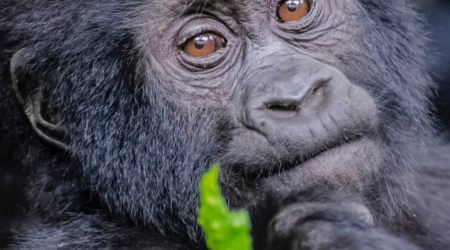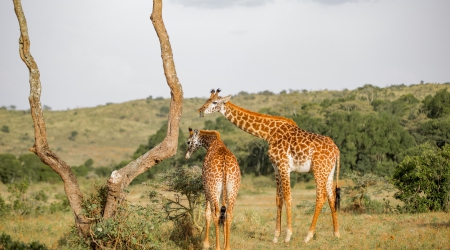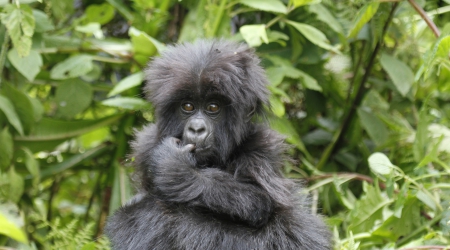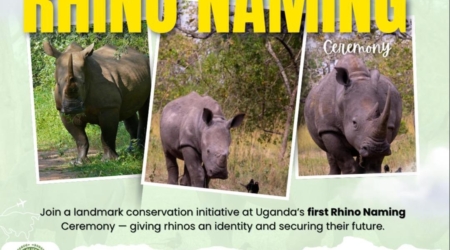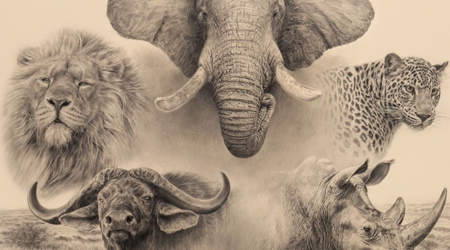The Ishasha Sector, located in the southern reaches of Queen Elizabeth National Park, presents a rare behavioral pattern among African lions.
Unlike other populations across the continent, lions in this sector have consistently been observed resting in tree branches. This arboreal habit, though limited to select locations in Africa, is a defining trait of Ishasha’s lion pride.
The region draws consistent attention from researchers, photographers, and safari operators. The phenomenon of tree-dwelling lions has shaped how this sector is positioned in Uganda’s tourism offering.
Where Is Ishasha? An Untamed Corner of Queen Elizabeth National Park
Ishasha is located in the southernmost part of Queen Elizabeth National Park, within Kanungu District in western Uganda.
The sector borders the Democratic Republic of Congo, with the Ishasha River forming a natural boundary between the two countries. Its position places it within the Albertine Rift, a region recognized for high ecological endemism and wildlife concentration.
From Kampala, Ishasha can be accessed via the Mbarara–Ntungamo–Kihihi–Ishasha route, covering approximately 470 kilometres by road.
The drive takes between 8 and 10 hours, depending on weather and road conditions. An alternative route passes through Queen Elizabeth National Park’s northern circuits, allowing visitors to explore the Mweya Peninsula before continuing south.
For air access, Kihihi Airstrip, located about 65 kilometres from Ishasha Gate, offers scheduled domestic flights from Entebbe.
Besides being a prime wildlife zone on its own, Ishasha serves as a logical stopover for tourists connecting to Bwindi Impenetrable National Park.
The Buhoma sector of Bwindi, known for gorilla trekking, lies just 70 kilometres away. This proximity enables visitors to integrate tree-lion tracking with gorilla tourism in a single circuit.
Why Do the Lions Climb Trees? Scientific and Practical Theories
The lions of Ishasha exhibit a behavior rarely observed among their species. They frequently rest on the branches of fig and acacia trees, often several meters above ground level.
This habit contrasts with the ground-dwelling nature typical of other African lion populations. Field observations over several decades suggest that this is not an isolated incident but a consistent behavioral pattern among multiple prides.
Several explanations have been advanced to interpret this arboreal activity.
Thermoregulation
One widely accepted theory attributes it to thermoregulation. The elevated position provides a cooler environment, particularly during the hot midday hours when ground temperatures rise significantly.
The open branches also allow free air circulation, reducing body heat accumulation.
Comfort
Another theory considers the avoidance of ground-based insects. Ishasha’s environment supports tsetse flies and other biting insects that are less active at higher elevations. By climbing trees, lions reduce irritation and conserve energy that would otherwise be lost through constant defensive movements.
Vantage Point
In addition to comfort, the elevated position provides a strategic advantage.
From tree branches, lions gain a clear view of potential prey, including Uganda kob, topi, and buffalo herds. This improved visibility supports both vigilance and territorial control. Observers have noted that the lions descend swiftly when prey movements intensify nearby.

Social Behaviour
Researchers also suggest a social learning component. Younger cubs imitate adults, gradually normalizing tree-climbing as a habitual behavior.
This intergenerational transmission supports the argument that Ishasha’s lions have culturally adapted to their environment rather than evolved physiologically for tree life.
Comparable behavior has been recorded in northern Tanzania’s Lake Manyara National Park, yet Ishasha’s consistency and frequency remain unmatched.
The Best Time to See Tree-Climbing Lions in Ishasha
Uganda has a bimodal rainfall pattern, which defines visitor experiences across most protected areas.
Ishasha follows this climate rhythm, with dry seasons from December to February and June to August, and wet seasons from March to May and September to November. These cycles influence both wildlife behavior and road accessibility.
The dry season offers the most reliable window for observing Ishasha’s tree-climbing lions. During this period, the grass is shorter and visibility improves significantly. Lions are easier to locate as they climb trees more frequently to escape the ground heat. Game drive tracks remain accessible, and tourism logistics operate with minimal disruption.
On the other hand, wet-season drives can be unpredictable. Roads become slippery, grass overgrowth limits line of sight, and animals may shift their movements.
While sightings are still possible, your chances may depend more on timing and the skill of your guide. If you’re visiting in April or November, carry waterproof gear and prepare for slower game drive routes.
Regardless of season, the mid-morning to early afternoon window, between 10:30 am and 2:00 pm, remains the most consistent time for tree-lion observations.
Lions tend to ascend trees after their early morning hunts and remain there until the late afternoon hours.
Visitors are encouraged to approach sightings with patience. Unlike zoo settings, these lions move on their own terms.
You might drive several kilometres before finding a pride in the canopy, but when it happens, the visual imprint is lasting.
Lodges, Game Drives, and Conservation
Accommodation in Ishasha is intentionally limited to preserve ecological balance. Lodges are located close to the Ishasha River and around the primary game drive circuit.
Notable facilities include Ishasha Wilderness Camp, a tented lodge situated near the Ntungwe River, and Enjojo Lodge, located along the Katokye Gate access road. Both offer vehicle access to the fig tree zones within 15 to 20 minutes.
Lodges operate on a full board and provide early morning or late afternoon game drives. These are conducted in open-roof safari vehicles, usually with a trained Uganda Wildlife Authority guide. Roads are unpaved but motorable in the dry season.
Game drives follow designated loops around areas known for lion sightings, buffalo concentrations, and kob breeding grounds.
If you’re coordinating your own transport, ensure that your vehicle has high clearance and four-wheel drive capacity.
Tourism in Ishasha operates under the jurisdiction of the Uganda Wildlife Authority (UWA), which regulates entry, movement, and visitor conduct.
Daily park entrance fees apply and are standardized across all Queen Elizabeth National Park sectors. Wildlife conservation in Ishasha is funded through a combination of park revenue, conservation grants, and community partnerships.
Local communities, through UWA’s revenue-sharing model, receive a percentage of park income to support healthcare, education, and livelihood projects.
Unlike more commercialised safari zones, Ishasha maintains a low-volume visitor profile. This contributes to both wildlife security and tourist satisfaction.
Game drives are rarely crowded. It is not unusual for one safari vehicle to have an entire lion sighting to itself.
READ ALSO: Choosing the best Safari Lodge for your Trip.
Safari Tips for Spotting the Tree-Climbing Lions
If you’re heading into Ishasha to observe its tree-climbing lions, a few technical decisions will improve your odds.
Start with timing. The best hours for sightings are between 10:30 am and 2:00 pm, when lions climb trees to escape the ground heat. Early morning or dusk drives may yield other species, but lions tend to remain on the ground during those periods.
Use the southern circuit game drive loop, especially the road sections near known fig tree clusters.
Guides often refer to landmarks like “tree 13” or “fig 7,” shorthand terms based on previous sightings. You may want to ask about these when booking your guide or lodge.
Choose a guide with local knowledge of the lion pride’s recent movements. The prides are not radio-collared, and their positions shift weekly depending on prey density and weather conditions.
A guide based inside the Ishasha sector, rather than just in Mweya or outside the park, will offer better spatial awareness.
Drive slowly and scan the upper branches carefully. Lions are sometimes partially hidden by leaves or resting motionless on thick limbs.
A good pair of binoculars or a DSLR with a telephoto zoom improves your chances of spotting subtle movements.
Prepare your gear the night before. Dust can affect lenses, so carry cleaning cloths.
If you’re using a phone, stabilisation and zoom quality will be limited as there’s no workaround for that. Patience and silence inside the vehicle make a difference, especially if lions are alert or unsettled.
Lastly, avoid driving off-track in search of closer views. Not only is this a violation of park rules, but it may also disturb resting lions and reduce the quality of sightings for others.

Why the Tree-Climbing Lions of Ishasha Are Worth the Journey
The lions of Ishasha represent a behavioral anomaly in African big cat ecology. Their consistent use of tree branches for rest, observation, and comfort has positioned this sector as a globally significant tourism and wildlife research destination.
Very few places offer such a predictable opportunity to witness this rare habit in the wild.
Ishasha complements Uganda’s tourism map by offering something distinct from gorilla trekking, chimpanzee tracking, or traditional savannah game drives.
If you’re constructing a multi-site itinerary through western Uganda, be sure to include Ishasha. It adds ecological variety and photographic value without requiring long detours or added border crossings.
In a tourism environment that increasingly values specialization and authenticity, Ishasha’s lions stand as a singular attraction.
Plan the visit carefully, align with experienced guides, and arrive with informed expectations. The lions will do the rest.







